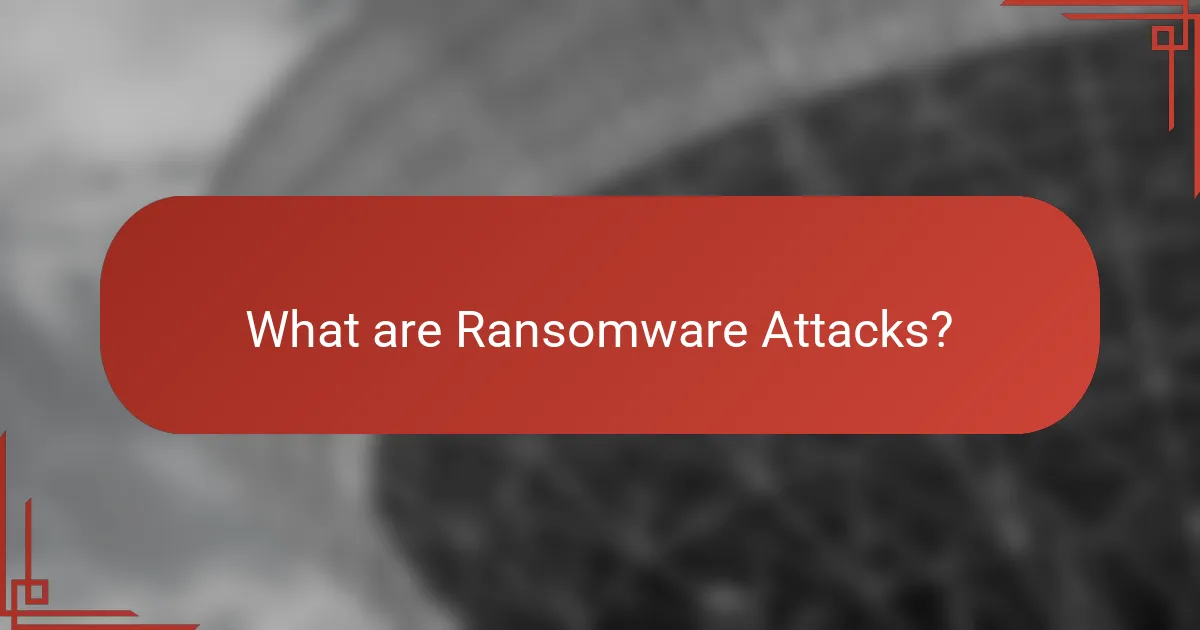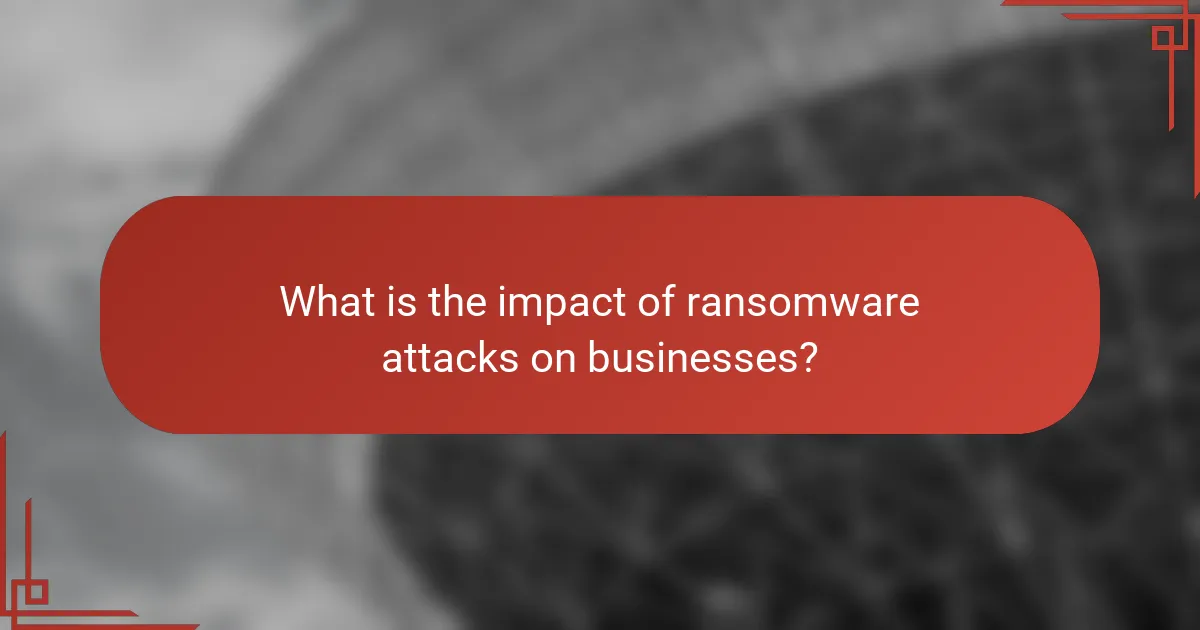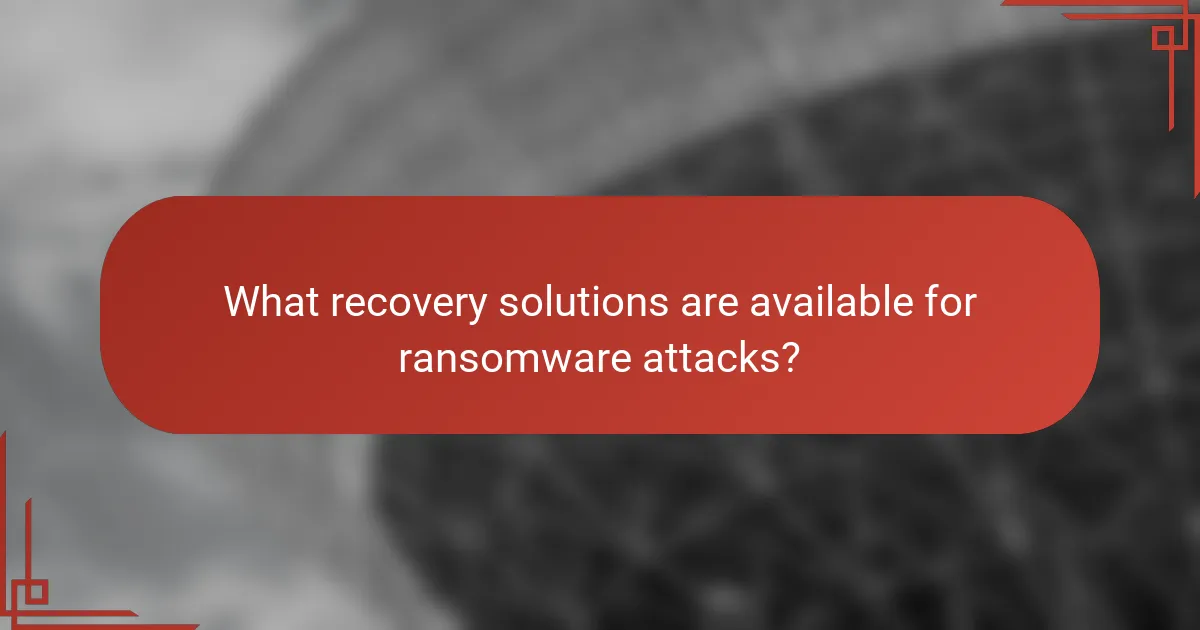Ransomware attacks are malicious software designed to block access to computer systems or data by encrypting files, with attackers demanding ransom payments for restoration. These attacks have surged in recent years, particularly affecting sectors like healthcare and finance, leading to significant disruptions in business operations, data loss, and financial damages. Recovery solutions include data backups, decryption tools, and incident response plans, which are essential for mitigating the impact of such incidents. Understanding the types of ransomware, their effects on businesses, and effective recovery strategies is crucial for organizations to safeguard against these threats.

What are Ransomware Attacks?
Ransomware attacks are a type of malicious software designed to block access to a computer system or data. Attackers typically encrypt files or systems, rendering them unusable. They demand a ransom payment to restore access. According to the Cybersecurity & Infrastructure Security Agency (CISA), ransomware attacks have increased significantly in recent years. In 2021, the FBI reported over 3,000 ransomware incidents, causing billions in damages. These attacks target various sectors, including healthcare and finance, to maximize impact. Ransomware can spread through phishing emails or unpatched software vulnerabilities.
How do ransomware attacks initiate?
Ransomware attacks typically initiate through phishing emails or malicious downloads. Cybercriminals send emails containing infected attachments or links. When users click on these links, malware is downloaded onto their systems. This malware then encrypts files, rendering them inaccessible. Additionally, ransomware can spread through vulnerabilities in software or unsecured networks. According to the Verizon Data Breach Investigations Report, 94% of malware is delivered via email. This highlights the importance of user awareness and security measures in preventing such attacks.
What methods do attackers use to deploy ransomware?
Attackers use various methods to deploy ransomware. Common techniques include phishing emails, which trick users into clicking malicious links. Exploit kits are also utilized to take advantage of software vulnerabilities. Remote Desktop Protocol (RDP) attacks allow unauthorized access to systems. Additionally, attackers may use malicious attachments in emails to deliver ransomware. Drive-by downloads occur when users visit compromised websites. Lastly, social engineering tactics manipulate individuals into revealing sensitive information. These methods enable attackers to effectively spread ransomware and compromise systems.
What are the common vulnerabilities that ransomware exploits?
Ransomware commonly exploits vulnerabilities in outdated software and operating systems. These vulnerabilities arise from unpatched security flaws. Attackers often target weak passwords and lack of multi-factor authentication. Misconfigured network settings also provide entry points for ransomware. Phishing emails are frequently used to trick users into downloading malicious attachments. Remote Desktop Protocol (RDP) vulnerabilities can allow unauthorized access to systems. Insufficient backups leave organizations vulnerable to data loss. According to Cybersecurity & Infrastructure Security Agency (CISA), these are prevalent entry points for ransomware attacks.
What types of ransomware exist?
There are several types of ransomware. The main categories include crypto-ransomware, locker ransomware, and scareware. Crypto-ransomware encrypts files, making them inaccessible until a ransom is paid. Locker ransomware locks users out of their devices, preventing access to any files or applications. Scareware often displays false alerts, tricking users into believing their system is compromised and demanding payment to fix it. Each type targets users differently, but all aim to extort money. According to cybersecurity reports, ransomware attacks have increased significantly, impacting businesses globally.
What is the difference between crypto-ransomware and locker ransomware?
Crypto-ransomware encrypts files on a victim’s system, making them inaccessible without a decryption key. Locker ransomware, on the other hand, locks the user out of their device without encrypting files. Crypto-ransomware typically demands payment for decryption, while locker ransomware may demand payment to regain access to the device itself. The main distinction lies in the method of attack and the type of access denied to the user. Crypto-ransomware affects individual files, whereas locker ransomware restricts overall device usage. This difference influences the recovery strategies that victims may pursue.
How do scareware and DDoS ransom attacks operate?
Scareware and DDoS ransom attacks operate through different mechanisms. Scareware typically involves deceptive software that misleads users into believing their system is compromised. It often displays fake alerts and prompts users to pay for removal tools. This creates panic and urgency, pushing users to act without verifying the claims.
DDoS ransom attacks involve overwhelming a target’s online services with traffic. Attackers use a network of compromised devices to flood the target, causing disruptions. The attackers then demand a ransom to stop the assault. This method can incapacitate businesses, leading to financial losses.
Both types of attacks exploit psychological manipulation and technical vulnerabilities. According to a report by Cybersecurity Ventures, the cost of cybercrime is projected to reach $10.5 trillion annually by 2025. This statistic highlights the growing impact of such attacks on businesses and the importance of robust cybersecurity measures.

What is the impact of ransomware attacks on businesses?
Ransomware attacks significantly disrupt business operations. They often lead to data loss, financial damage, and reputational harm. According to a 2021 report by Cybersecurity Ventures, ransomware damages are expected to reach $20 billion by 2021. Businesses may face ransom payments, recovery costs, and potential regulatory fines. Downtime can result in lost revenue and decreased productivity. Additionally, customer trust may erode, affecting long-term relationships. The impact can be particularly severe for small to medium-sized enterprises, which may lack robust cybersecurity measures.
How do ransomware attacks affect business operations?
Ransomware attacks severely disrupt business operations. These attacks encrypt critical data, rendering it inaccessible. Consequently, employees cannot perform their tasks effectively. Downtime can lead to significant financial losses. According to Cybersecurity Ventures, ransomware damages are projected to reach $265 billion by 2031. Businesses may also incur costs from recovery efforts and potential ransom payments. Additionally, customer trust can diminish, affecting long-term relationships. Overall, ransomware attacks create a cascade of operational challenges and financial burdens for affected businesses.
What are the immediate consequences of a ransomware attack?
Immediate consequences of a ransomware attack include data encryption and system inaccessibility. Organizations may face operational disruptions as critical systems become unusable. This can lead to significant downtime, affecting productivity and revenue. Additionally, there may be financial losses due to ransom payments, recovery costs, and potential regulatory fines. The attack can also damage the organization’s reputation, eroding customer trust. According to a 2021 report by Cybersecurity Ventures, ransomware damages are projected to reach $20 billion by 2021, highlighting the financial impact.
How can ransomware attacks impact a company’s reputation?
Ransomware attacks can severely damage a company’s reputation. These attacks lead to data breaches, which erode customer trust. When sensitive information is compromised, clients may feel their privacy is at risk. This can result in customer attrition as individuals seek more secure alternatives. Additionally, public knowledge of an attack can attract negative media coverage. A tarnished reputation can also affect partnerships and investor confidence. According to a 2021 report by Cybersecurity Ventures, 60% of small businesses close within six months of a cyber attack. Thus, the impact on reputation can have long-term financial consequences for a company.
What are the financial implications of ransomware attacks?
Ransomware attacks have significant financial implications for businesses. These attacks can lead to direct costs such as ransom payments, which averaged $570,000 in 2021 according to a report by Palo Alto Networks. Indirect costs include operational downtime, which can reach up to $1.85 million per incident as per IBM’s Cost of a Data Breach Report 2022. Recovery expenses can further escalate, with companies spending thousands on cybersecurity measures post-attack. Additionally, businesses may face legal fees and regulatory fines, especially if customer data is compromised. The overall financial impact can result in losses totaling millions, affecting both short-term cash flow and long-term profitability.
How much can businesses lose due to ransomware attacks?
Businesses can lose an average of $1.85 million due to ransomware attacks. This figure includes direct costs like ransom payments and indirect costs such as downtime and recovery expenses. According to a report by Cybersecurity Ventures, the total cost of ransomware attacks is expected to reach $265 billion by 2031. In 2021 alone, the average ransom payment increased to approximately $570,000. Downtime can cost businesses up to $8,000 per minute, adding to the financial impact. Additionally, reputational damage can lead to long-term revenue loss.
What additional costs are associated with recovery from ransomware attacks?
Additional costs associated with recovery from ransomware attacks include data recovery expenses, system restoration fees, and potential legal costs. Data recovery often requires specialized software or services, which can be expensive. System restoration may involve hardware upgrades or replacements, increasing overall expenses. Legal costs can arise from compliance failures or lawsuits related to data breaches. Moreover, businesses may face reputational damage, leading to lost revenue and customer trust. According to a report by Cybersecurity Ventures, the global cost of ransomware is projected to reach $265 billion by 2031, highlighting the financial impact of such attacks.

What recovery solutions are available for ransomware attacks?
Recovery solutions for ransomware attacks include data backups, decryption tools, and incident response plans. Regularly backing up data ensures that organizations can restore their systems without paying a ransom. Decryption tools may help recover files without payment, depending on the ransomware variant. Incident response plans guide organizations in containing the attack and mitigating damage. Cybersecurity firms often provide specialized recovery services to assist affected businesses. According to Cybersecurity & Infrastructure Security Agency (CISA), having a robust recovery strategy reduces the impact of ransomware incidents.
How can businesses prepare for ransomware attacks?
Businesses can prepare for ransomware attacks by implementing comprehensive cybersecurity measures. Regularly updating software and operating systems reduces vulnerabilities. Conducting employee training on phishing and security awareness is crucial. Establishing a robust data backup strategy ensures data recovery without paying ransoms. Implementing network segmentation limits the spread of attacks. Utilizing advanced threat detection tools can identify potential breaches early. Regularly testing incident response plans prepares teams for actual attacks. According to the Cybersecurity & Infrastructure Security Agency, organizations with backup solutions are less likely to pay ransoms.
What preventive measures can reduce the risk of ransomware attacks?
Implementing regular data backups significantly reduces the risk of ransomware attacks. Backups should be performed frequently and stored offline or in a secure cloud environment. Keeping software and operating systems updated helps close security vulnerabilities that attackers exploit. Utilizing robust antivirus and anti-malware solutions can detect and neutralize threats before they cause damage. Educating employees about phishing and social engineering tactics is crucial, as these are common entry points for ransomware. Employing strong password policies and multi-factor authentication adds an additional layer of security. Network segmentation limits the spread of ransomware within an organization. Regularly testing incident response plans ensures preparedness in case of an attack.
How important is employee training in combating ransomware?
Employee training is crucial in combating ransomware. It equips staff with the knowledge to recognize phishing attempts and suspicious activities. According to a report by the Ponemon Institute, human error is a leading cause of ransomware attacks. The study found that 95% of cybersecurity breaches are due to human mistakes. Regular training sessions can significantly reduce these errors. Organizations that implement comprehensive training programs see a decline in successful attacks. Therefore, investing in employee education is essential for enhancing cybersecurity measures against ransomware.
What steps should businesses take after a ransomware attack?
Businesses should immediately isolate affected systems after a ransomware attack. This helps prevent the malware from spreading. Next, they should assess the extent of the damage. Identify which files and systems are compromised. Notify law enforcement to report the attack. This is crucial for potential investigations. Businesses should also inform stakeholders about the incident. Transparency can help maintain trust. After that, they need to restore data from backups. Ensure that backups are clean and unaffected by the ransomware. Finally, it is essential to review and improve security measures. This includes updating software and training employees on cybersecurity awareness.
How can businesses effectively recover their data after an attack?
Businesses can effectively recover their data after an attack by implementing a comprehensive data recovery plan. This plan should include regular backups stored securely offsite. According to a 2021 report by the Cybersecurity and Infrastructure Security Agency, 93% of companies that lost their data center for 10 days or more filed for bankruptcy within one year. Therefore, timely backups are crucial.
Additionally, businesses should conduct regular security assessments to identify vulnerabilities. This proactive approach helps prevent future attacks. After an attack, businesses should analyze the incident to understand how it occurred. This analysis aids in strengthening defenses against similar attacks.
Furthermore, engaging with cybersecurity professionals can provide expertise in recovery processes. They can assist in data restoration and system integrity checks. Lastly, businesses should communicate transparently with stakeholders about the recovery efforts. This builds trust and ensures everyone is informed.
What role does cybersecurity insurance play in recovery?
Cybersecurity insurance plays a crucial role in recovery from ransomware attacks. It provides financial support to cover costs associated with data breaches and cyber incidents. This support may include expenses for incident response, legal fees, and public relations efforts. According to a report by the Cyber Risk Management (CRM) Council, businesses with cybersecurity insurance can recover more swiftly from attacks. The coverage can also help mitigate losses from business interruption. Additionally, it often includes access to cybersecurity experts who can assist in recovery efforts. Thus, cybersecurity insurance is vital for managing the financial implications of ransomware incidents.
What best practices can help mitigate future ransomware threats?
Implementing regular data backups is essential to mitigate future ransomware threats. These backups should be stored offline or in a secure cloud environment. Keeping software and systems updated reduces vulnerabilities that attackers exploit. Using robust antivirus and anti-malware solutions adds an additional layer of protection. Educating employees about phishing and social engineering tactics is critical. Establishing a comprehensive incident response plan prepares organizations for potential attacks. Regularly testing recovery processes ensures that data can be restored quickly. According to the Cybersecurity & Infrastructure Security Agency, organizations that implement these practices significantly reduce their risk of ransomware attacks.
How can regular backups protect against ransomware attacks?
Regular backups can protect against ransomware attacks by providing a secure copy of data that can be restored. When ransomware encrypts files, having recent backups allows organizations to recover their data without paying the ransom. This strategy minimizes downtime and financial loss. According to a 2021 report by Cybersecurity Ventures, businesses that implement regular backups can reduce the impact of ransomware by up to 90%. Effective backup solutions include offsite storage and cloud-based systems. These methods ensure data availability even if the primary system is compromised. Regularly testing backups is essential to ensure they are functional when needed.
What security tools are essential for preventing ransomware attacks?
Essential security tools for preventing ransomware attacks include antivirus software, firewalls, and backup solutions. Antivirus software detects and removes malicious software before it can execute. Firewalls monitor and control incoming and outgoing network traffic based on predetermined security rules. Backup solutions ensure data is regularly saved and can be restored in case of an attack. Additionally, endpoint detection and response (EDR) tools provide real-time monitoring and threat detection. Security awareness training for employees helps mitigate risks by educating them on recognizing phishing attempts and suspicious activity. Regular software updates and patch management are crucial for closing vulnerabilities that ransomware may exploit. These tools collectively create a robust defense against ransomware threats.
Ransomware attacks are a form of malicious software that disrupt access to computer systems or data by encrypting files and demanding ransom payments for restoration. This article examines the initiation methods, common vulnerabilities exploited by ransomware, and the various types, including crypto-ransomware, locker ransomware, and scareware. It also outlines the significant financial and reputational impacts on businesses, emphasizing the importance of recovery solutions and preventive measures, such as regular data backups and employee training, to mitigate future risks. Additionally, the role of cybersecurity insurance in recovery efforts is discussed, providing a comprehensive understanding of ransomware threats and responses.


